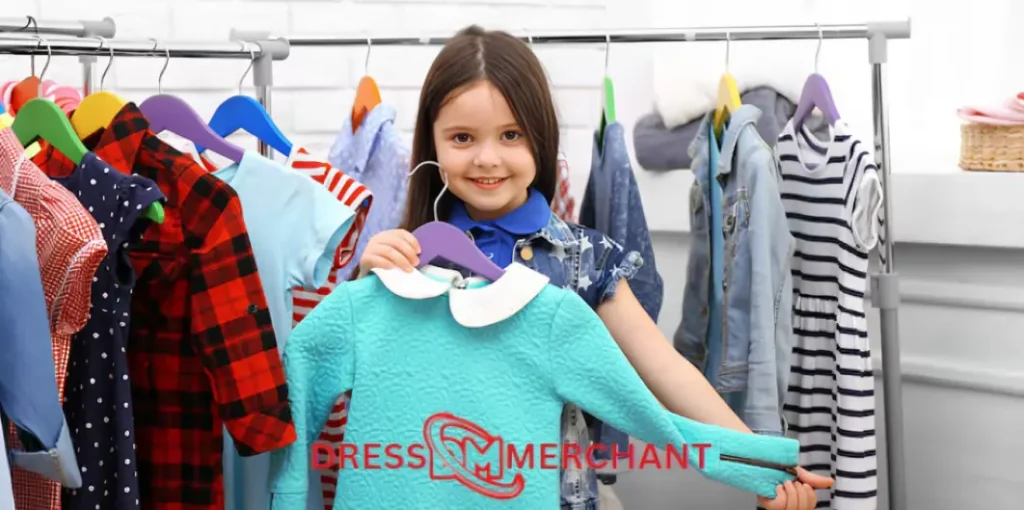Looking for a trusted Bangladesh Clothing Supplier for Kidswear? Discover high-quality, comfortable, and stylish children’s apparel crafted with care. Our collection features trendy designs, vibrant colors, and durable fabrics perfect for kids of all ages. Whether you need bulk orders or customized styles, our expert team ensures timely delivery and competitive pricing. Choose us as your go-to Bangladesh Clothing Supplier for Kidswear for unmatched value and reliability.
Thank you for reading this post, don't forget to subscribe!
1. Introduction to Bangladesh’s Kidswear Industry
1.1 Overview of the Apparel Sector in Bangladesh
Bangladesh has emerged as a global leader in the textile and garment industry, currently ranking as the second-largest exporter of ready-made garments (RMG) in the world, just behind China. The sector contributes more than 80% to the country’s total export earnings and employs millions, particularly women, making it a cornerstone of both economic growth and social development.
Over the years, Bangladesh has gained a strong reputation for producing quality apparel at competitive prices while meeting strict compliance standards. Within this robust framework, the kidswear segment has gained remarkable momentum, transforming from a niche category into a significant contributor to the industry’s overall revenue.
The increasing specialization in children’s apparel—ranging from newborn essentials to fashion-forward clothing for older kids—reflects the evolving capabilities of Bangladeshi manufacturers.
1.2 Rising Demand for Kidswear Globally
Globally, the kidswear market is witnessing exponential growth, driven by shifting consumer lifestyles, rising disposable incomes, and heightened awareness around fashion trends for children. Modern parents are increasingly discerning buyers—they seek not only style and variety but also emphasize comfort, skin-friendly fabrics, durability, and ethical production standards.
With greater focus on organic materials, sustainable practices, and child-safe designs, the demand for trustworthy suppliers has grown sharply. Bangladesh has adapted rapidly to these trends, making strides in eco-friendly textile manufacturing, child-safe garment construction, and social compliance, thereby positioning itself as a preferred sourcing destination for global retailers.
The influence of e-commerce and international retail chains has further expanded the reach of Bangladeshi kidswear into markets that were previously untapped.
1.3 Bangladesh’s Position in Global Kidswear Export
Today, Bangladesh exports a wide range of children’s clothing—from casual wear and school uniforms to seasonal and occasion-specific apparel—to some of the world’s most prominent fashion retailers.
Leading global brands from Europe, North America, Australia, and Asia rely on Bangladeshi suppliers for cost-effective, high-quality, and timely deliveries. The country’s growing focus on compliance, skilled workforce, and continuous technological upgrades in manufacturing processes has strengthened its foothold in the international kidswear landscape.
As the global demand for stylish and sustainable kidswear rises, Bangladesh is well-equipped to meet and exceed market expectations.
2. Why Choose a Bangladesh Clothing Supplier for Kidswear?
2.1 Cost-Effective Production
Venturing into the kidswear market demands a keen eye on profitability, and Bangladesh emerges as a compelling hub for cost-effective production. The country’s economic landscape allows suppliers to offer significantly competitive pricing without compromising the integrity of the final product.
This advantage stems from a combination of factors, including streamlined operational costs and a skilled workforce. By leveraging these efficiencies, businesses can secure high-quality kidswear at a fraction of the cost compared to suppliers in many other regions.
This allows for healthier profit margins, greater flexibility in pricing strategies, and the potential to reinvest savings into other crucial aspects of the business, such as design innovation or marketing initiatives. Ultimately, the cost-effectiveness of Bangladeshi suppliers empowers businesses to thrive in the dynamic and often price-sensitive children’s apparel market.
2.2 High Standards of Manufacturing
While affordability is a significant draw, it’s equally important to emphasize that Bangladeshi clothing suppliers for kidswear adhere to stringent international manufacturing standards.
A significant portion of the industry operates under globally recognized certifications such as BSCI (Business Social Compliance Initiative), WRAP (Worldwide Responsible Accredited Production), and SEDEX (Supplier Ethical Data Exchange). These certifications are not mere badges; they signify a deep commitment to quality control throughout the production process, ensuring that the garments meet international safety regulations – a paramount concern for children’s wear.
Furthermore, these standards underscore ethical labor practices, guaranteeing fair treatment and safe working conditions for the garment workers. This commitment to ethical and quality manufacturing provides buyers with the assurance that they are receiving products that are not only well-made and safe for children but also produced responsibly.
2.3 Flexible Order Quantities
The kidswear market is diverse, encompassing everything from small, independent boutiques to large, multinational retail chains. Recognizing this spectrum, Bangladeshi clothing suppliers offer a significant advantage through their flexible order quantity options.
Whether a buyer requires a smaller production run to cater to a niche market or a substantial volume for widespread distribution, suppliers in Bangladesh demonstrate the adaptability to meet these varying demands. This flexibility is particularly beneficial for startups and smaller businesses that may not have the capacity for large initial orders.
It also allows larger retailers to test new designs or manage inventory more effectively. This accommodating approach positions Bangladeshi suppliers as versatile partners, capable of supporting businesses across the entire spectrum of the kidswear industry, fostering long-term collaborations built on mutual scalability and growth.
3. Product Range Offered by Kidswear Suppliers in Bangladesh
Bangladeshi kidswear suppliers cater to a comprehensive spectrum of children’s clothing needs, demonstrating versatility and an understanding of different developmental stages and requirements.
Their extensive product range encompasses everything from the delicate essentials for newborns to trendy and robust outfits for older children, highlighting the maturity and breadth of the industry.
3.1 Baby Apparel
The baby apparel segment is a cornerstone of the offerings from kidswear suppliers in Bangladesh. Recognizing the delicate nature of infant skin and the practical needs of new parents, these suppliers produce a diverse collection of clothing designed for comfort and ease of use.
This includes a wide variety of onesies, available in different sleeve lengths and fabrics, ensuring babies are snug and comfortable in any climate. Bibs, essential for feeding times, are manufactured in various absorbent materials and designs. Suppliers also offer sleepwear, such as footed pajamas and sleep sacks, prioritizing safety and warmth. Furthermore, the range extends to bodysuits, rompers, and newborn sets, often crafted from ultra-soft, breathable, and hypoallergenic fabrics with secure, baby-safe fastenings to facilitate easy dressing and diaper changes. Attention to detail, such as tagless designs and flat seams, underscores the focus on infant well-being.
3.2 Toddler and Preschool Clothing
As children transition into their toddler and preschool years, their clothing needs shift towards items that accommodate increased mobility and playfulness. Kidswear suppliers in Bangladesh rise to this challenge by producing a vibrant and durable range of rompers and dungarees, offering comfortable and unrestricted movement for active little ones. Playwear sets, often featuring colorful patterns and engaging designs, are manufactured from robust materials that can withstand the rigors of playtime.
The product line also includes a variety of tops, t-shirts, trousers, leggings, and dresses, designed with both style and practicality in mind. Easy-to-manage closures and comfortable fits are key features, empowering young children to dress themselves and move freely.
The emphasis on durable fabrics ensures that these garments can endure frequent washing and energetic activities, making them a reliable choice for parents.
3.3 School-Age Clothing
The school-age demographic requires clothing that balances style, comfort, and durability, and Bangladeshi suppliers adeptly cater to this segment. A significant portion of their production includes school uniforms, adhering to specific design and material requirements while ensuring comfort for long school days.
Beyond uniforms, suppliers manufacture a wide array of everyday wear, such as jeans, casual shirts, sweaters, and skirts, keeping up with current trends while maintaining practicality. Outerwear, including jackets and sweatshirts, provides warmth and protection during cooler months.
The focus here is on creating garments that can withstand daily wear and tear, offering both style and functionality for active school children. Attention is also paid to sizing accuracy and consistent quality to meet the demands of this important market segment.
3.4 Seasonal and Occasion Wear
Recognizing the diverse needs of their global clientele, kidswear suppliers in Bangladesh also offer specialized collections for different seasons and occasions. Their seasonal collections include warm winter jackets, sweaters, and thermal wear designed to provide insulation and comfort during colder periods. Conversely, they produce lightweight and breathable summer dresses, shorts, and swimwear suitable for warmer climates.
Additionally, these suppliers cater to special events by offering a range of occasion wear, including festive outfits, party dresses, and formal attire for children. These garments often feature more intricate designs, embellishments, and special fabrics, allowing children to dress appropriately and stylishly for various celebrations and formal gatherings.
The ability to produce both practical everyday wear and specialized seasonal and occasion-based clothing underscores the comprehensive capabilities of the kidswear manufacturing sector in Bangladesh.
4. Ethical and Sustainable Manufacturing Practices
The global apparel industry is increasingly recognizing the critical importance of ethical and sustainable manufacturing practices. Consumers are more conscious of the social and environmental impact of their clothing choices, driving a demand for greater transparency and accountability throughout the supply chain.
In Bangladesh, a significant hub for garment production, a growing number of manufacturers are embracing these principles, moving beyond traditional production models to prioritize people and the planet.
4.1 Child-Safe Materials
Ensuring the safety and well-being of children is paramount, especially when it comes to the materials used in their clothing. Suppliers in Bangladesh are increasingly adhering to stringent regulations concerning fabric sourcing and dyeing processes.
A key aspect of this commitment involves the use of OEKO-TEX certified materials. This certification guarantees that textiles have been tested for harmful substances and pose no risk to human health, including that of vulnerable infants and children. Furthermore, manufacturers are prioritizing skin-friendly dyes and finishes, minimizing the potential for allergic reactions or skin irritation.
This focus on child-safe materials reflects a growing ethical awareness and a dedication to producing garments that are not only aesthetically pleasing but also safe for their intended wearers.
4.2 Green Manufacturing Technologies
The environmental impact of textile manufacturing, particularly dyeing and finishing processes, can be substantial. Recognizing this, many forward-thinking suppliers in Bangladesh are actively adopting green manufacturing technologies to minimize their ecological footprint.
This transition involves the implementation of innovative practices such as water-saving dyeing methods, which significantly reduce water consumption and wastewater discharge. Furthermore, a growing number of factories are investing in renewable energy sources like solar power to decrease their reliance on fossil fuels and lower carbon emissions.
The adoption of zero-liquid-discharge (ZLD) systems represents a significant step towards environmental sustainability, ensuring that all wastewater is treated and recycled within the factory, preventing pollution of local water sources. These technological advancements demonstrate a commitment to environmentally responsible production and a move towards a more circular economy within the garment sector.
4.3 Social Compliance and Fair Wages
Beyond environmental considerations, ethical manufacturing also encompasses the social well-being of the workers who are the backbone of the garment industry. In Bangladesh, there is a growing emphasis among manufacturers on social compliance and ensuring fair labor practices.
This includes offering fair wages that meet or exceed legal requirements and provide workers with a decent standard of living. Creating safe and healthy workplaces is another crucial aspect, with manufacturers investing in improved factory infrastructure, safety protocols, and occupational health provisions.
Moreover, a growing number of companies are recognizing the importance of social security benefits for their employees, contributing to their long-term well-being and financial stability. This increasing focus on worker welfare reflects a shift towards a more socially responsible manufacturing model, acknowledging the fundamental rights and dignity of garment workers.
5. Technological Advancements in Kidswear Production
The kidswear industry, like many others, is experiencing a significant transformation driven by technological advancements. These innovations are not only optimizing production processes but also leading to the creation of more functional, safer, and aesthetically appealing garments for children. From design conceptualization to the final packaging, technology is playing an increasingly vital role in shaping the future of kidswear manufacturing.
5.1 CAD and CAM Integration
The integration of Computer-Aided Design (CAD) and Computer-Aided Manufacturing (CAM) systems has revolutionized the initial stages of kidswear production. CAD software empowers designers to create intricate and detailed garment designs digitally, allowing for easy modifications, pattern adjustments, and virtual prototyping. This digital approach significantly reduces the need for physical samples in the early stages, saving time and resources.
Subsequently, CAM technology translates these digital designs into precise instructions for automated cutting and sewing machinery. This seamless transition from design to manufacturing ensures a high degree of accuracy and consistency in the final product, minimizing errors and material wastage.
The synergy between CAD and CAM not only accelerates the entire design-to-production cycle but also enables manufacturers to respond more swiftly to evolving fashion trends and consumer demands in the dynamic kidswear market.
5.2 Smart Fabric Innovations
Beyond traditional textiles, the kidswear sector is witnessing exciting developments in smart fabric innovations. Researchers and manufacturers are actively exploring materials with functionalities that go beyond basic clothing.
For instance, fabrics that can sense and respond to temperature fluctuations, providing warmth in cooler conditions and breathability in warmer climates, are being developed.
Furthermore, the integration of UV protective properties directly into the fabric composition is gaining traction, offering an added layer of safety for children during outdoor activities. These smart fabric innovations aim to enhance the functionality and practicality of kidswear, addressing specific needs and concerns of parents regarding their children’s comfort and well-being.
While still in relatively early stages of widespread adoption, the potential of smart fabrics to transform the kidswear industry is immense, promising garments that are not just aesthetically pleasing but also actively contribute to a child’s comfort and safety.
5.3 Automation in Sewing and Packaging
The introduction of automation in the traditionally labor-intensive processes of sewing and packaging is significantly impacting the efficiency and scalability of kidswear production. Semi-automated machinery equipped with advanced sensors and robotic arms are being implemented to handle repetitive tasks such as stitching seams, attaching fasteners, and folding garments.
This automation leads to a substantial increase in production speed and throughput, enabling suppliers to meet larger order volumes more effectively.
Moreover, the precision offered by automated systems minimizes the occurrence of human errors, resulting in higher quality and more consistent finished products. In the packaging stage, automated systems can efficiently wrap, label, and prepare kidswear items for distribution, further streamlining the supply chain.
While complete automation across all stages may still be some time away, the increasing adoption of semi-automated solutions is undoubtedly enhancing productivity, reducing costs, and improving the overall efficiency of kidswear manufacturing operations.
6. Design Capabilities and Customization Options
Bangladeshi kidswear suppliers distinguish themselves through robust design capabilities and extensive customization options, empowering businesses to create unique and appealing product lines. This focus on tailored solutions allows clients to effectively address specific market demands and build strong brand identities.
6.1 In-House Design Teams
A significant advantage offered by many top-tier suppliers is the presence of dedicated in-house creative teams. These teams are deeply immersed in the dynamic world of kidswear fashion trends, constantly monitoring emerging styles, color palettes, and popular themes. Their expertise allows them to translate market insights into innovative and commercially viable designs.
By collaborating closely with these in-house teams, clients can leverage their knowledge to develop custom designs that resonate with their target audience and align seamlessly with current market needs.
This collaborative approach streamlines the design process, ensuring both creative vision and manufacturing feasibility are considered from the outset.
6.2 Private Label Services
Recognizing the importance of brand identity, Bangladeshi suppliers readily offer both white-label and private label services. White-label options provide clients with generic, unbranded garments that can be easily tagged and sold under their own label. Private label services extend this further, allowing clients to develop and manufacture entire collections under their own brand name, often with customized designs and specifications.
This flexibility empowers businesses to cultivate their brand presence, build customer loyalty, and differentiate themselves in a competitive marketplace. Whether a client seeks a simple entry into the market or aims to establish a unique brand aesthetic, these private label services offer a tailored pathway to achieving their goals.
6.3 Custom Prints and Embellishments
Bangladeshi suppliers excel in catering to specific branding and design requirements through a diverse array of customization techniques. They offer a wide selection of printing methods, from screen printing to digital printing, enabling intricate and vibrant designs to be applied to garments.
Furthermore, their expertise extends to various forms of embroidery, adding texture and a touch of artisanal quality. Appliqué work, involving the stitching of fabric pieces onto garments, provides another avenue for creative expression. Finally, a vast range of embellishments, such as beads, sequins, and ribbons, allows for the addition of unique and eye-catching details that can elevate the overall appeal of the kidswear.
This comprehensive suite of customization options ensures that clients can translate their creative visions into tangible products that perfectly reflect their brand identity and capture the attention of their target consumers.
7. Logistics and Export Infrastructure
Bangladesh’s burgeoning export sector is underpinned by a developing logistics and export infrastructure that offers several key advantages to international buyers. This infrastructure, while still evolving, provides a solid foundation for efficient and reliable sourcing.
7.1 Strategic Geographic Location
Nestled at the crossroads of South and Southeast Asia, Bangladesh benefits immensely from its strategic geographic location. Its proximity to major international shipping routes in the Bay of Bengal facilitates relatively swift and cost-effective logistics to both Western and burgeoning Asian markets. This advantageous positioning reduces transit times and transportation costs, making Bangladeshi goods more competitive globally.
Furthermore, access to key regional markets like India and Southeast Asia presents opportunities for diversified export destinations and regional trade partnerships. The ongoing development of inland waterways and connectivity projects aims to further enhance this locational advantage, streamlining the movement of goods from production hubs to international ports.
7.2 Export-Ready Documentation
Bangladeshi suppliers have gained considerable experience in navigating the complexities of international trade documentation. They are generally well-versed in preparing and managing essential export documents, including certificates of origin that verify the goods’ origin for customs purposes, pre-shipment inspection reports ensuring quality and compliance with agreed-upon standards, and various compliance certifications related to product safety, environmental regulations, and labor standards.
This proficiency in handling export paperwork streamlines the customs clearance process at both the exporting and importing ends, minimizing delays and ensuring smoother transactions for international buyers.
The increasing adoption of digital documentation and electronic data interchange is further enhancing the efficiency and accuracy of this crucial aspect of the export process.
7.3 Efficient Shipping and Freight Forwarding
The Bangladeshi export sector has fostered strong partnerships with a diverse range of global shipping lines and experienced freight forwarding companies. These collaborations ensure timely and reliable delivery of shipments to destinations worldwide. Suppliers can leverage these established networks to access competitive freight rates and a variety of shipping options tailored to their specific needs, whether it be containerized shipping, air freight, or specialized cargo handling.
Moreover, the integration of advanced tracking systems provides real-time visibility of shipments, allowing both suppliers and buyers to monitor the progress of their goods and proactively address any potential logistical challenges.
The continuous investment in port infrastructure and the modernization of customs procedures are further contributing to the efficiency of shipping and freight forwarding operations in Bangladesh.
8. Quality Control and Assurance Processes
Maintaining exceptional quality in garment production demands a comprehensive and systematic approach. Suppliers implement robust quality control and assurance processes throughout the entire manufacturing lifecycle, ensuring that the final products meet the required standards and customer expectations.
These processes encompass various stages and methodologies, contributing to the overall reliability and desirability of the garments.
8.1 Multi-Stage Inspection Systems
Garment suppliers employ meticulous multi-stage inspection systems as a cornerstone of their quality control efforts. This proactive approach involves thorough examinations at critical junctures of the production process, starting from the initial raw materials.
Incoming fabrics, threads, and accessories are rigorously inspected for defects in quality, color consistency, and adherence to specifications. During the sewing and assembly stages, in-process inspections identify and rectify any construction flaws, ensuring proper stitching, seam strength, and accurate sizing.
Finally, a comprehensive final inspection is conducted on the finished garments before packing. This multi-layered approach minimizes the chances of defects progressing through the production line, ultimately safeguarding the quality of the final product.
8.2 Independent Lab Testing
To further guarantee product quality and safety, particularly for sensitive categories like children’s clothing, manufacturers often subject their products to independent lab testing. These certified laboratories conduct a range of tests to verify compliance with relevant safety standards and regulations.
This may include assessments for harmful substances, flammability, durability, and other critical parameters. The unbiased evaluation provided by independent labs offers an additional layer of assurance, confirming that the garments meet stringent safety requirements and are suitable for their intended use.
This commitment to independent testing underscores the supplier’s dedication to product safety and consumer well-being.
8.3 Customer Feedback Integration
A crucial aspect of maintaining high satisfaction levels and continuously improving production processes is the integration of customer feedback. Manufacturers actively solicit and analyze feedback from their clients regarding product quality, design, and overall satisfaction.
This valuable input provides direct insights into areas where improvements can be made. By systematically incorporating customer feedback into their production cycles, manufacturers can fine-tune their processes, address any recurring issues, and ensure that their products consistently meet or exceed customer expectations.
This iterative approach fosters a culture of continuous improvement and strengthens the partnership between suppliers and their clients.
9. Case Studies of Successful Partnerships
9.1 Collaborations with European Retailers
For decades, Bangladeshi garment manufacturers have forged strong and enduring partnerships with prominent European kidswear retailers. These collaborations are built on a foundation of consistent quality, reliability, and an understanding of the evolving fashion trends in the European market.
Bangladeshi suppliers have demonstrated their ability to adhere to stringent quality control measures, ethical sourcing standards, and timely delivery schedules, making them trusted partners for brands seeking dependable production. 1 Furthermore, many suppliers have invested in design and development capabilities, actively collaborating with European retailers on seasonal collections, offering innovative styles and fabrications that resonate with consumers.
This long-term commitment and adaptability have solidified Bangladesh’s position as a key sourcing hub for European kidswear, fostering mutual growth and shared success. The deep understanding of European market demands, coupled with competitive pricing, makes these partnerships particularly advantageous for retailers seeking to offer high-quality children’s clothing at accessible price points.
9.2 Supplying Startups and SMEs
Beyond established giants, Bangladesh has also emerged as a preferred sourcing destination for burgeoning startups and small to medium-sized enterprises (SMEs) in the kidswear sector.
These smaller brands often benefit from the flexibility offered by Bangladeshi manufacturers, particularly in terms of Minimum Order Quantities (MOQs). Unlike larger factories that may require substantial production volumes, many Bangladeshi suppliers are willing to accommodate smaller runs, enabling startups to launch their collections without significant upfront investment in inventory.
Moreover, a significant advantage lies in the design collaboration support offered by many Bangladeshi factories. These suppliers often possess in-house design teams or are willing to work closely with emerging brands to develop unique and trend-forward kidswear designs, providing crucial support in the early stages of brand development.
This collaborative spirit and willingness to cater to the specific needs of startups and SMEs make Bangladesh an invaluable partner for fostering innovation and growth in the global kidswear market.
9.3 Scaling with Global Fashion Giants
The capabilities of Bangladeshi garment suppliers extend to meeting the complex demands of multinational fashion retailers. Several manufacturers have successfully scaled their operations to handle the large volumes and intricate logistical requirements of these global giants while consistently maintaining high standards of quality.
This scaling involves significant investments in infrastructure, technology, and workforce training to ensure efficient production processes and adherence to international quality benchmarks. These suppliers have demonstrated their ability to navigate complex supply chains, implement robust quality control systems, and meet the ethical and sustainability standards increasingly expected by global consumers.
The ability to consistently deliver large volumes of high-quality kidswear has enabled these Bangladeshi suppliers to become integral partners in the global sourcing strategies of major fashion retailers, contributing significantly to their supply chain resilience and market competitiveness. This demonstrates the maturity and sophistication of the Bangladeshi garment industry, capable of catering to the diverse needs of the global kidswear market, from nimble startups to established multinational corporations.
10. Navigating Compliance and Certifications
The landscape of the global apparel industry is heavily influenced by a complex web of compliance standards and certifications. For Bangladeshi garment suppliers, demonstrating adherence to these requirements is not merely a matter of ticking boxes; it’s fundamental to accessing international markets and building trust with buyers and consumers alike.
This intricate system encompasses international certifications, government oversight, and the specific ethical standards demanded by individual buyers.
10.1 Key International Certifications
A multitude of global certifications serve as tangible proof of a supplier’s commitment to various aspects of responsible manufacturing. These certifications provide a standardized framework that assures buyers of certain qualities and practices. For instance, the Global Organic Textile Standard (GOTS) signifies that textiles are made with organically produced raw materials, processed under strict environmental and social criteria throughout the entire supply chain.
Similarly, OEKO-TEX certifications, such as Standard 100, guarantee that textile products are free from harmful levels of over 100 substances known to be detrimental to human health.
Beyond environmental and material standards, certifications like ISO 9001 focus on quality management systems, ensuring consistent product quality and customer satisfaction through well-defined processes.
Furthermore, SA8000 addresses social accountability, verifying that workplaces adhere to fair labor practices, including aspects like worker health and safety, fair wages, and the absence of child or forced labor. Holding these internationally recognized certifications provides Bangladeshi suppliers with a significant competitive edge, signaling their dedication to global best practices.
10.2 Government Oversight and Audits
In Bangladesh, the Bangladesh Garment Manufacturers and Exporters Association (BGMEA) plays a crucial role in ensuring industry-wide compliance. Recognizing the importance of maintaining a positive global image and sustainable growth, the BGMEA actively conducts regular factory audits.
These audits serve to monitor and enforce adherence to national labor laws, safety regulations, and environmental standards within garment manufacturing facilities. This proactive approach by the BGMEA helps to foster a culture of compliance within the industry and provides a layer of assurance to international stakeholders regarding the operational integrity of Bangladeshi suppliers.
The government’s support and collaboration with the BGMEA are vital in maintaining these oversight mechanisms.
10.3 Buyer-Driven Ethical Standards
In addition to internationally recognized certifications and government oversight, many international buyers implement their own unique sets of compliance protocols. These buyer-driven ethical standards often go beyond general industry requirements, reflecting the specific values and expectations of individual brands and retailers. Bangladeshi suppliers, having long been key players in the global supply chain, possess considerable experience in accommodating these diverse and often stringent demands.
This adaptability and willingness to meet specific buyer requirements, which can cover areas like environmental sustainability, labor conditions, and supply chain transparency, have been instrumental in solidifying Bangladesh’s position as a major garment manufacturing hub.
The ability of local suppliers to navigate and adhere to these varied ethical standards is a testament to their maturity and commitment to responsible business practices.
11. Challenges and Risk Management
11.1 Seasonal Demand Fluctuations
The inherent variability in consumer demand across different seasons presents a significant hurdle for suppliers. During peak seasons, there’s often a surge in orders, demanding increased production capacity and a larger workforce. Conversely, off-seasons witness a considerable dip in demand, leading to potential overstocking and underutilization of resources.
This fluctuating pattern necessitates careful planning and agile operational strategies. To navigate these challenges, suppliers are increasingly adopting flexible production schedules, allowing them to scale operations up or down as needed. This might involve utilizing temporary staff, outsourcing certain production stages, or strategically managing inventory levels to meet anticipated demand while minimizing storage costs during slower periods.
Furthermore, effective forecasting techniques and close communication with buyers are crucial for anticipating these seasonal shifts and adjusting production accordingly.
11.2 Geopolitical and Trade Barriers
The global nature of supply chains exposes suppliers to a complex web of geopolitical factors and trade regulations. Changes in trade policies, the imposition of new tariffs, or the emergence of trade disputes between importing and exporting countries can directly and negatively impact export volumes and profitability. These external factors introduce a layer of uncertainty that requires proactive risk management. To mitigate these risks, astute suppliers are increasingly focusing on diversifying their export markets.
By reducing reliance on a single or a limited number of importing nations, they can cushion the impact of adverse policy changes in any one region. Exploring new markets and building relationships with diverse buyers enhances resilience and ensures a more stable flow of exports despite potential geopolitical headwinds.
11.3 Climate and Environmental Risks
Bangladesh’s geographical location makes it particularly vulnerable to a range of climate and environmental risks. Frequent natural disasters such as floods, cyclones, and extreme weather events can cause significant disruptions to supply chains, affecting transportation, production facilities, and the availability of raw materials. Recognizing this inherent vulnerability, the establishment of robust disaster management systems within the supply chain is paramount.
This includes developing contingency plans for potential disruptions, investing in infrastructure that can withstand climate-related events, and establishing efficient communication channels for early warning and response. Furthermore, adopting sustainable practices and environmentally conscious production methods can contribute to long-term resilience by mitigating the environmental factors that exacerbate these risks.
Collaboration between suppliers, government agencies, and international organizations is crucial in building a comprehensive and effective risk management framework to address these climate and environmental challenges.
12. How to Choose the Right Kidswear Supplier in Bangladesh
Selecting the ideal kidswear supplier in Bangladesh is a critical decision that significantly impacts the quality, cost-effectiveness, and overall success of your business.
The country has emerged as a global hub for garment manufacturing, offering a wide array of potential partners. However, navigating this landscape requires careful consideration and due diligence.
By focusing on key aspects such as product portfolios, factory transparency, and contractual agreements, you can make an informed choice that aligns with your brand’s values and objectives.
12.1 Evaluating Product Portfolios
A crucial first step in identifying the right supplier involves a thorough review of their existing and past product lines. Examining their kidswear portfolio provides valuable insights into several key areas. You can assess the variety of designs they have produced, gauging their creativity and ability to cater to different styles and trends within the children’s wear market.
Furthermore, scrutinizing the quality of their previous work offers a tangible indication of their manufacturing standards and attention to detail. Understanding their production capabilities, including the types of garments they can handle and their scalability, is also essential to ensure they can meet your specific needs and volume requirements.
By analyzing their product portfolio, you can determine if their aesthetic, quality standards, and production capacity align with your brand’s vision.
12.2 Factory Visits and Virtual Tours
Gaining firsthand insight into a supplier’s operations is paramount in establishing trust and ensuring ethical and quality production. Conducting on-site factory visits, when feasible, allows you to directly observe their manufacturing processes, working conditions, and quality control measures.
This provides a comprehensive understanding of their operational efficiency and adherence to safety standards. In situations where physical visits are challenging, virtual tours have become an increasingly valuable alternative. These virtual audits offer a remote yet detailed view of the factory floor, enabling you to assess their facilities and processes from afar.
Whether through physical presence or virtual exploration, these direct engagements foster transparency and allow you to verify that the supplier’s practices align with your ethical and quality expectations.
12.3 Contractual Terms and Sampling Policies
Establishing clear and comprehensive contractual terms is fundamental to building a strong and sustainable partnership with your kidswear supplier. The contract should explicitly outline crucial aspects such as pricing, production timelines, quality standards, shipping arrangements, and intellectual property rights.
A well-defined agreement minimizes the potential for misunderstandings and provides a framework for a mutually beneficial collaboration. Equally important are the supplier’s sampling policies.
A robust sampling process allows you to evaluate the quality and design accuracy of the garments before committing to bulk production. Clear procedures for requesting, reviewing, and approving samples are essential to ensure that the final products meet your specifications and quality benchmarks.
By prioritizing transparent contractual terms and a thorough sampling process, you lay the groundwork for a reliable and long-term partnership with your chosen kidswear supplier in Bangladesh.
13. Future Outlook of Kidswear Production in Bangladesh
The kidswear production sector in Bangladesh stands at an exciting juncture, poised for significant evolution and expansion. Building upon its established manufacturing prowess, the industry is strategically adapting to global trends and embracing innovative approaches to secure its future growth and sustainability.
This outlook is characterized by a proactive engagement with the digital marketplace, a commitment to upskilling its workforce, and a determined focus on forging environmentally and ethically sound international collaborations.
13.1 Expansion into E-Commerce Fulfillment
The burgeoning global e-commerce landscape presents a significant opportunity for Bangladesh’s kidswear manufacturers. Recognizing this shift in consumer behavior, suppliers are increasingly diversifying their service offerings beyond traditional bulk production. A notable trend is the growing adoption of dropshipping and direct-to-customer (D2C) services.
This allows manufacturers to directly engage with international online retailers and even end consumers, bypassing traditional intermediaries. By streamlining logistics and offering flexible fulfillment options, Bangladeshi suppliers can tap into the vast potential of online retail, catering to smaller order quantities and faster delivery demands.
This move not only broadens their market reach but also enhances their competitiveness in the rapidly evolving digital marketplace.
13.2 Investment in Skill Development
Acknowledging the need for a highly skilled workforce to meet the demands of a more sophisticated and sustainability-focused industry, Bangladesh is witnessing increased investment in skill development initiatives within the children’s apparel sector.
Both governmental and private organizations are actively fostering training programs designed to enhance workforce expertise across various aspects of production. These programs encompass technical skills such as advanced sewing techniques, pattern making, and quality control, as well as crucial areas like sustainable manufacturing practices, digital design, and supply chain management.
By nurturing a highly competent talent pool, Bangladesh aims to elevate the quality and innovation within its kidswear production, ensuring it remains a globally competitive and reliable sourcing destination.
13.3 Focus on Sustainable Global Partnerships
Looking ahead, a key strategic priority for Bangladesh’s kidswear industry is to solidify its position as a responsible and ethical manufacturing hub. This involves a concerted effort to strengthen long-term partnerships with global brands that prioritize environmental sustainability and ethical sourcing.
Bangladeshi manufacturers are increasingly adopting eco-friendly production methods, exploring the use of sustainable materials, and implementing transparent and fair labor practices. By aligning with the values of eco-conscious brands and demonstrating a commitment to responsible manufacturing, Bangladesh aims to build trust and foster enduring collaborations that contribute to a more sustainable and ethical global apparel industry.
This focus on sustainability will not only enhance its international reputation but also open doors to new and value-driven partnerships.
14. Conclusion: Bangladesh Clothing Supplier for Kidswear
Bangladesh’s kidswear manufacturing sector offers a perfect blend of affordability, quality, and ethical production. With its advanced infrastructure, skilled workforce, and adaptability to evolving global demands, Bangladesh stands out as a reliable partner for sourcing children’s clothing. As the global demand for kidswear rises, the country’s focus on innovation, sustainability, and client satisfaction solidifies its role as a key player in the global kidswear supply chain.













